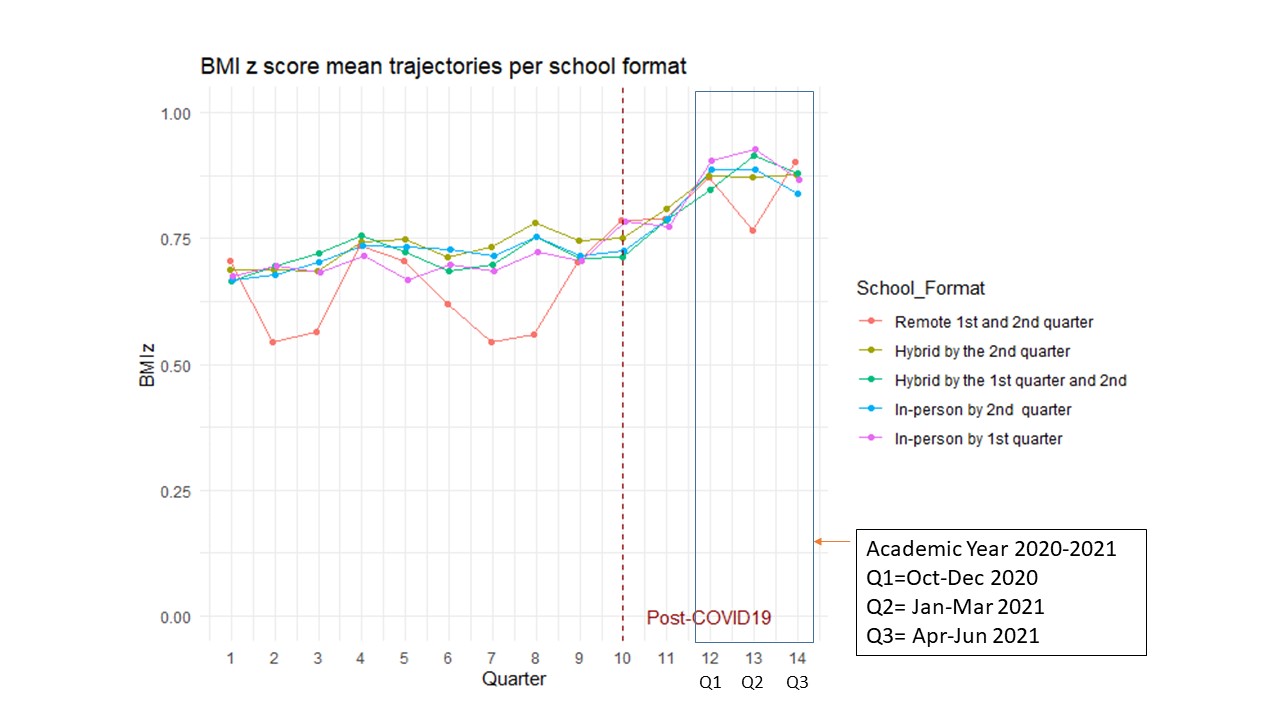Back
Obesity
Category: Abstract Submission
Obesity II
520 - Childhood Growth Trends and School Format Delivery during the Pandemic
Saturday, April 23, 2022
3:30 PM – 6:00 PM US MT
Poster Number: 520
Publication Number: 520.239
Publication Number: 520.239
Nazia Kulsum-Mecci, Children's Hospital of the University of Illinois, Peoria, IL, United States; Anshu Maheshwari, UICOMP, Peoria, IL, United States; Kejin Lee, University of Illinois College of Medicine, Peoria, IL, United States; Grant Williams, University of Illinois College of Medicine, Peoria, IL, United States; Michael J. Neff, University of Illinois College of Medicine, Peoria, IL, United States; Amy L. Christison, University of Illinois College of Medicine at Peoria, Peoria, IL, United States

Michael J. Neff
Medical Student
University of Illinois College of Medicine
Peoria, Illinois, United States
Presenting Author(s)
Background: Accelerated weight gain among children has occurred during the pandemic. Associated factors such as socioeconomic,racial, age,dietary,physical activity and sleep habit disruption have been described. to curb the spread of COVID, remote learning for students was implemented resulting in additional lifestyle changes for children which could have compounded these factors. The aim of this study is to describe the relationship between growth trajectories and school format delivery during pandemic for which we report preliminary descriptive analysis.
Objective: The primary objective of this study is to describe relationship between growth trajectories and school format delivery during pandemic
Design/Methods: This was a retrospective study of 2-18 year old pediatric records in a regional health care system with a minimum of 2 biologically plausible weight.height measures prior to (1/2018- 3/2020) and 1 measure during pandemic (4/2020-6/2021) from ambulatory encounters. Demographic characteristics,insurance type, city and zip codes were also abstracted. The Illinois state Board of Education database containing school district instructional format changes were categorized as in-person, hybrid and remote by calendar quarter. Each patient was then assigned an instructional format/quarter from this database by matching the patient residential with the school district city and zip code data. Descriptive quarterly cross-sectional trends of calculated mean BMIZ-scores were examined by instructional format and other demographic factors prior to growth curve modeling.
Results: 43,336 unique patients included in the analysis had higher BMIz-score trends during the pandemic compared to the 2 years prior(more so ages 2-10 years) with a reduction in the second quarter of 2021( more so ages 16-18 years). (Figure 1) A shift to higher BMI categories ( healthy weight to overweight, overweight to obesity) increased as the year 2020 progressed(Table 1). though all instructional formats experienced increase in BMIz score trends, decreased occurred more in the last quarter ( 4-6/2021) of the school year among the earlier in person or hybrid adoption( Figure 2).Conclusion(s): Our findings confirm increasing growth curves during pandemic. These may mitigated early adoption of in-person or hybrid learning format during 2020-2021 school year. We next plan to use regression analysis to create adjusted growth curve modeling using slope changes between unique patient measures which will further elucidate this trend. we plan to further analyze demographic factors that are associated with significant weight gain in this cohort of children.
Figure 1.jpg)
Figure 2
Objective: The primary objective of this study is to describe relationship between growth trajectories and school format delivery during pandemic
Design/Methods: This was a retrospective study of 2-18 year old pediatric records in a regional health care system with a minimum of 2 biologically plausible weight.height measures prior to (1/2018- 3/2020) and 1 measure during pandemic (4/2020-6/2021) from ambulatory encounters. Demographic characteristics,insurance type, city and zip codes were also abstracted. The Illinois state Board of Education database containing school district instructional format changes were categorized as in-person, hybrid and remote by calendar quarter. Each patient was then assigned an instructional format/quarter from this database by matching the patient residential with the school district city and zip code data. Descriptive quarterly cross-sectional trends of calculated mean BMIZ-scores were examined by instructional format and other demographic factors prior to growth curve modeling.
Results: 43,336 unique patients included in the analysis had higher BMIz-score trends during the pandemic compared to the 2 years prior(more so ages 2-10 years) with a reduction in the second quarter of 2021( more so ages 16-18 years). (Figure 1) A shift to higher BMI categories ( healthy weight to overweight, overweight to obesity) increased as the year 2020 progressed(Table 1). though all instructional formats experienced increase in BMIz score trends, decreased occurred more in the last quarter ( 4-6/2021) of the school year among the earlier in person or hybrid adoption( Figure 2).Conclusion(s): Our findings confirm increasing growth curves during pandemic. These may mitigated early adoption of in-person or hybrid learning format during 2020-2021 school year. We next plan to use regression analysis to create adjusted growth curve modeling using slope changes between unique patient measures which will further elucidate this trend. we plan to further analyze demographic factors that are associated with significant weight gain in this cohort of children.
Figure 1
.jpg)
Figure 2

